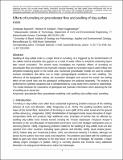Effects of tunneling on groundwater flow and swelling of clay-sulfate rocks
Author(s)
Butscher, Christoph; Einstein, Herbert H.; Huggenberger, Peter
DownloadEinstein_Effects of tunneling.pdf (4.156Mb)
OPEN_ACCESS_POLICY
Open Access Policy
Creative Commons Attribution-Noncommercial-Share Alike
Terms of use
Metadata
Show full item recordAbstract
[1] Swelling of clay-sulfate rocks is a major threat in tunneling. It is triggered by the transformation of the sulfate mineral anhydrite into gypsum as a result of water inflow in anhydrite-containing layers after tunnel excavation. The present study investigates the hydraulic effects of tunneling on groundwater flow and analyzes how hydraulic changes caused by excavation lead to water inflow into anhydrite-containing layers in the tunnel area. Numerical groundwater models are used to conduct scenario simulations that allow one to relate hydrogeological conditions to rock swelling. The influence of the topographic setting, the excavation-damaged zone around the tunnel, the sealing effect of the tunnel liner, and the geological configuration are analyzed separately. The analysis is performed for synthetic situations and is complemented by a case study from a tunnel in Switzerland. The results illustrate the importance of geological and hydraulic information when assessing the risk of swelling at an actual site.
Date issued
2011-11Department
Massachusetts Institute of Technology. Department of Civil and Environmental EngineeringJournal
Water Resources Research
Publisher
American Geophysical Union (AGU)
Citation
Butscher, Christoph, Herbert H. Einstein, and Peter Huggenberger. “Effects of Tunneling on Groundwater Flow and Swelling of Clay-sulfate Rocks.” Water Resources Research 47.11 (2011).
Version: Author's final manuscript
ISSN
0043-1397